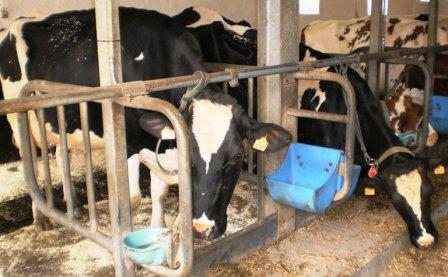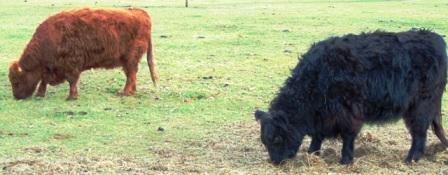A cow (Bos taurus) gives an average of 25 liters of milk per day 315 days per year. This equates to 7,875 liters.
In 1900 this was about 2,500 liters of milk, and in 2006 was already up to 7,800 or even 12,000 liters per year.
A cow can be 20 years, but is in the dairy average only 5 to 6 years.
There are more than 1,000 different cattle breeds worldwide.
A newborn calf weighs about 40 kg and is in a year to 160 kg heavier at a cattle farmer.
Cows roar according to a 2006 British study with their own local dialect, based on that of their owner / caretaker. Due to the construction of their knees and their weight distribution, cows can climb stairs, but not down.
 In the vesicles of the udder milk is formed by milk -producing cells that reach the necessary constituents of the blood. There should be 300 to 400 liters of blood to circulate in order to make one liter of milk.
In the vesicles of the udder milk is formed by milk -producing cells that reach the necessary constituents of the blood. There should be 300 to 400 liters of blood to circulate in order to make one liter of milk.
In principle, a cow is in the first 10 months after a calf is born milked twice a day. They must therefore yearly go to the bull and have a calf to give milk.
A cow eats about 13 to 16 kg of dry matter(DM) or 2 to 2.5% of its body weight per day (depending on age, quality, yield..). Depending on additional feed that is 40 to 80 kilograms of grass / day. They drink 50 liters of water( and more). If she gives milk, and it is hot and dry, this rises to more than 200 liters / day.
Lactating animals have a great water requirement: a dairy cow has four extra liters of water needed for each liter of milk produced.
A cow that can plan her own day grazes eight hours in three rounds: at dawn, in the late afternoon and midnight (especially at full moon). In a loose house they eat less than two hours outside.
Manure spots are not grazed. Thus, they avoid recontamination with intestinal worms.
They clamp the grass between the tongue and the teeth of the lower jaw, pull it with a short head movements of the ground and grind it between the lower teeth and jaws. The cow is a ruminant with four stomachs.
If the rumen (first stomach) is full, the fermented grass comes back into the mouth and is chewed. The second stomach, the reticulum, passes it to the omasum. In this third stomach is the moisture from the digested food achieved. The fourth stomach, the abomasum is most similar to the stomach of non- ruminants and grinds everything very fine. Here, the food is digested by digestive juices and is passed to the small intestine.
Holstein - Friesian dairy cows are very popular. Animals of the dual-purpose type (milk and meat production) are currently rare. The types of meat gain extreme muscle: they are called (fat ass, or) Belgian blue. Rates of caesarean section run up to 100% for those extreme bodybuilded shapes.
Bulls got a ring through the nose (septum) to keep them under control and make them manageable. The nose is highly sensitive. Sometimes a lead rope was made from a horn to the ring.
There also exist tongs or nips to take a stallion or a bull by the nose.
Because they were so expensive small farmers also used to rent cows. In exchange for care, shelter and food they received significant manure, milk and muscle strength. The animals were also made usefull to plow and pull carts. The cow kept possession of the owner. Upon sale, the capital gain, the difference between the buying and the selling, was shared between the tenant and the owner, who will each receive half of those returns.
“Fantastic, I want that cow! “"What does it say? “' For sale: cow may calve every day. “(JW Besouw)
Cow: "Boo! “Other cow: "Exactly what I would say! "
A couple sees a bull busy. “Ellen, may I also? “"Well, that cow won’t refuse?”(Theo Bergsma)
“How much milk that cow gives?”"Twenty liters a day! “"How much do you sell?”“Thirty-six liters! “(Max Tailler)
(picture: Galloway)

